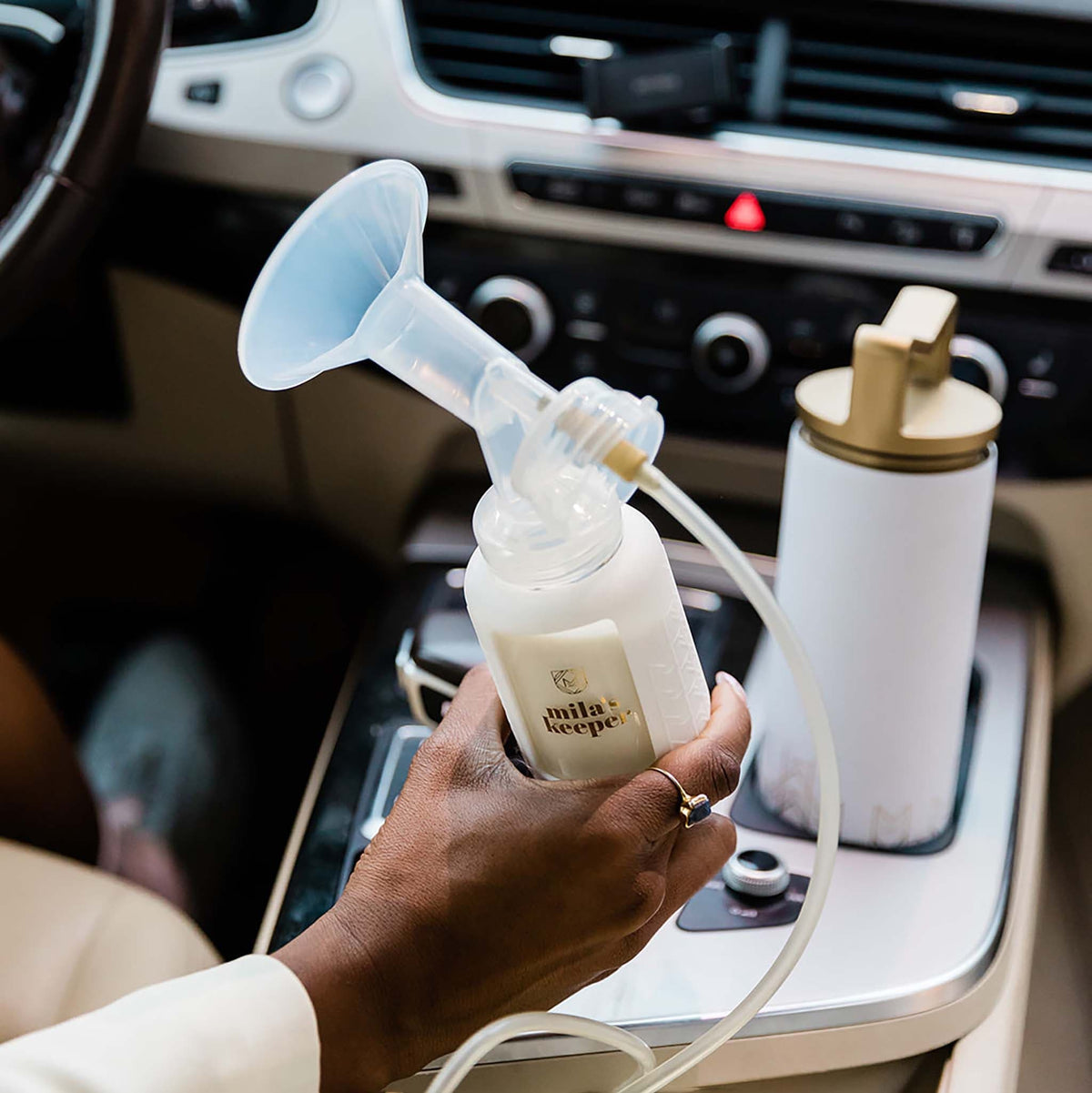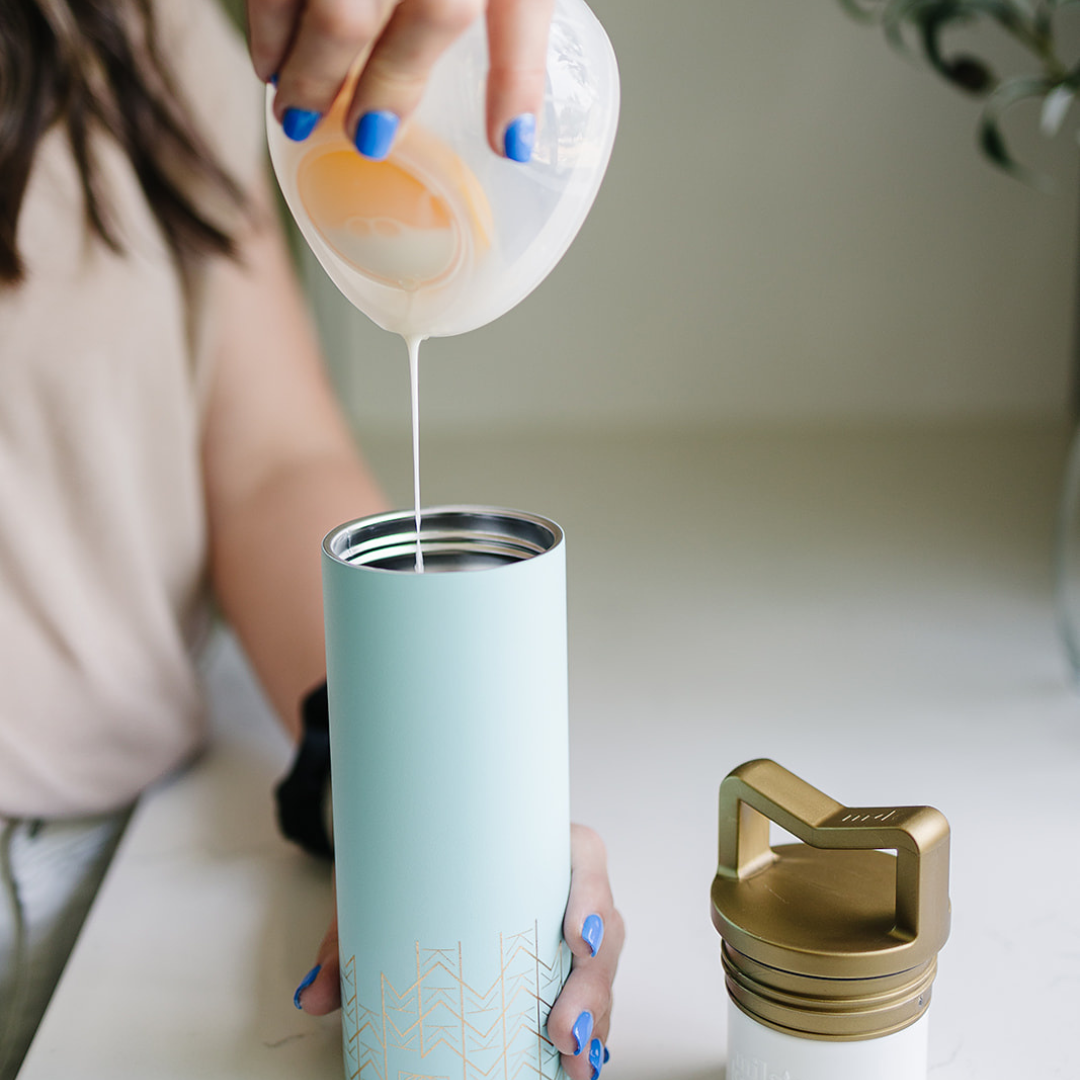Breastfeeding is all about your unique journey, and finding the right position is a big deal for both you and your baby’s comfort. We’re going to dig into the different ways to breastfeed, from sitting up to lying down, and how they can make the experience awesome for both of you. These feeding moments create a special bond between you and your little one. So let’s explore these options together and make your breastfeeding journey a beautiful and rewarding part of motherhood.
Choosing Between Breastfeeding Positions
When it comes to breastfeeding positions, comfort is crucial, not only for you but also for your baby. Tailoring your breastfeeding position to your baby’s age, size, and feeding preferences can make the experience smoother and more enjoyable for both of you.
In addition to your baby's physical development, it's important to pay attention to their unique feeding preferences. Babies are individuals from day one, and what works for one might not work for another. Some infants prefer a quiet and dimly lit environment for feeding, while others are more flexible and can nurse amidst distractions. Learning to read your baby's cues and adjusting your breastfeeding position accordingly can make a world of difference in terms of comfort and bonding during feeds.
A good latch is the foundation of successful breastfeeding. It involves your baby properly attaching to your breast, allowing them to effectively extract milk. The importance of this cannot be overstated, as a good latch ensures your baby receives the nourishment they need while also reducing the risk of painful complications for you, such as cracked nipples. A poor latch, on the other hand, can lead to an unhappy, fussy baby (and mama), and it may even result in insufficient milk supply.
According to UNICEF, the following are signs of a good latch:
- A comfortable experience with no pain.
- More areola is visible above your baby’s mouth than below.
- Your baby’s mouth is wide open.
- Their lower lip is turned out.
- Their chin is touching – or nearly touching – your breast.
The signs of good positioning are:
- Your baby’s head and body are in line. A baby cannot suckle or swallow easily if their head is twisted or bent.
- Your baby is held close to your body. A baby cannot attach well to the breast if they are far away from it.
- Your baby’s whole body is supported with your arm along their back. This is particularly important for newborns and young babies. For older babies, support of the upper part of the body is usually enough.
- Your baby approaches breast nose to nipple, so that they come to your breast from underneath the nipple.
The signs of effective suckling are:
- Your baby takes slow deep suckles, sometimes pausing.
- You may be able to see or hear your baby swallowing after one or two suckles.
- Suckling is comfortable and pain free for you.
- Your baby finishes the feed, releases the breast and looks contented and relaxed.
- Your breast is softer after the feed.
Now, let's not forget about the comfort of the person on the other side of this nurturing exchange – mom. Comfortable positioning is a game-changer for your breastfeeding journey. If you’re not comfortable while breastfeeding, or experiencing pain while breastfeeding, don't hesitate to seek support. Lactation consultants, healthcare professionals, and breastfeeding support groups can provide invaluable guidance and encouragement. You might also find that using supportive tools can make a big difference-try in pregnancy pillows from WildBird online shop, or any other reputable brand, to help you achieve a more relaxed and ergonomic position. Remember, your comfort matters just as much as your baby’s. Different positions like the cradle hold, football hold, and side-lying position can be explored to determine what suits you both best. You might need a little trial-and-error to find what suits you and your baby best.
Remember that the breastfeeding experience is unique to each mother and baby duo. It may take some time, but once you find the right combination of latch and positioning that works for both of you, it can transform the experience into one of the most beautiful and rewarding aspects of motherhood.
Upright Breastfeeding Positions for Newborns
Upright breastfeeding positions for newborns are gaining popularity as an alternative to the more traditional cradle or football holds. These positions offer a range of benefits that can make the breastfeeding experience more comfortable and efficient for both mom and baby.
These positions can be especially beneficial for newborns who may struggle with latching on correctly. Upright holds, like the koala hold or the supported straddle, provide better access to the breast for a baby with a shallow latch. This can help prevent sore nipples and ensure that the baby is effectively stimulating milk production. Some moms who suspect their baby is tongue-tied say that these upright positions help them get a better latch.
Upright breastfeeding positions can also offer greater comfort to the nursing mother. They reduce strain on the back, shoulders, and neck, which is helpful for postpartum recovery. In these positions, mothers can relax against a backrest or pillows, allowing for more enjoyable and extended feeding sessions.
When trying upright positions, you want to find the one that works best for both you and your baby. Experiment with various holds, and be patient in adapting to this new approach. The key is to prioritize your baby's comfort and latch while ensuring that you are at ease as well.
Another significant advantage of these positions is the closeness and intimacy they foster between mother and baby. The upright holds create a natural setting for bonding and connection. The eye contact and skin-to-skin contact that these positions encourage can deepen the emotional bond between mother and child, making breastfeeding not just a means of nourishment but also a special time for nurturing and bonding.
Getting the latch right in upright breastfeeding positions is essential for a comfortable and efficient nursing experience. Here are some tips to help you achieve a good latch in these positions:
- Proper Support: Ensure you have the right support for both yourself and your baby. Sit in a comfortable chair or use cushions to help support your back and arms. Your baby should be well-supported in an upright position, either in your lap or using a nursing pillow.
- Positioning: Position your baby so that their mouth is level with your nipple. You can use your hand to support your breast or gently compress the areola to make it easier for your baby to latch.
- Lip-to-Nipple Alignment: Make sure your baby's lips are flanged outward, like fish lips, and their tongue is down. The bottom lip should be below the nipple, and the top lip should be above. This alignment ensures a deeper latch and better milk transfer.
- Wait for the Open Mouth: Wait for your baby to open their mouth wide, like a big yawn. It's essential to time the latch when their mouth is at its widest to ensure a proper latch. When their mouth is open, quickly bring them onto the breast.
- Chin First: When latching, guide your baby's chin to the breast first, followed by the upper lip and nose. This approach ensures that the baby takes more of the areola into their mouth.
- Listen for Swallowing: As your baby starts feeding, listen for the sound of swallowing. You should hear soft, rhythmic swallows, which indicate that your baby is effectively transferring milk.
- Check for Comfort: Nursing should be pain-free. If you experience pain, it's a sign that the latch may not be right. You can gently break the latch by inserting a clean finger into the corner of your baby's mouth and trying again.
- Use a Nursing Pillow: A nursing pillow can help support your baby and bring them to the right level. It's especially helpful when using upright positions.
The Cradle/Cross-Cradle and Football
The cradle breastfeeding position is a classic and widely practiced method that’s beloved by many breastfeeding mamas. In this position, you hold your baby in the crook of your arm on the same side as the breast you’re nursing from. Your baby’s head rests comfortably in the bend of your elbow, and your other hand supports their back and shoulders.
This position offers a cozy and nurturing experience for both you and your baby. It’s excellent for newborns and older infants alike. One of the fantastic aspects of the cradle hold is that it allows you to maintain close eye contact with your baby, enhancing the bonding experience during feedings. Additionally, the cradle position gives you the flexibility to nurse almost anywhere, whether you’re at home or out and about.
The cross-cradle breastfeeding position is a fantastic addition to a breastfeeding mom’s toolkit. In this position, you support your baby’s head with the hand opposite to the breast you’re nursing on. Your other arm supports your baby’s back and body, allowing you to bring your little one close for a snug feeding experience.
One of the major perks of the cross-cradle position is the control it offers. You can guide your baby’s latch and head position with ease, making it an excellent choice, especially for newborns or babies who might need a bit more assistance in achieving a good latch.
The football breastfeeding position, also known as the clutch or underarm hold, is a unique and versatile way for nursing moms to feed their babies. In this position, you tuck your baby under your arm on the same side as the breast they’ll be nursing from, with their legs and body extended towards your back.
This approach is particularly handy if you’ve had a cesarean section, have large breasts, or your baby is small. The football hold provides excellent support and control, making it easier for your baby to latch on correctly. Plus, it offers a great view of your baby’s face, ensuring they’re comfortable and positioned well. Many mothers appreciate this position for its convenience and the flexibility it offers, especially when nursing in public.

The Side Lying or Lying Down Breastfeeding Positions
The lying down breastfeeding position is a game-changer for many mamas, offering a comfortable and relaxed way to nurse your baby. This position is especially valuable during nighttime feedings when the whole household could use a little more rest. Not only does it promote better sleep and rest for both mom and baby, but it also provides several other benefits that make it an appealing option for breastfeeding moms.
An elevated side-lying position might also be a better choice if you’re worried about your little one eating enough. One study showed that babies who were laid on their side in an elevated position ate more than those who were fed in a semi-elevated position.
If you’re bottle feeding with breast milk containers, the side-lying position might be worth trying. The position is similar to how a baby feeds at the breast and gives you a clear view of their face to watch for any signs of difficulty or discomfort. When the milk flows too fast, especially in the beginning when your baby is still getting the hang of coordinating their sucking, swallowing, and breathing, this position helps by letting the milk dribble out of your baby’s mouth instead of them coughing while feeding.
Benefits of the Lying Down Breastfeeding Position:
- Better Sleep: Nighttime feedings can be challenging, especially when you're exhausted. The lying down position allows you to nurse your baby while lying on your side, making it easier to fall back asleep during and after feedings.
- Reduced Strain: The lying down position eliminates the need to sit up or support your baby's weight with your arms and back. This can help reduce strain on your body, which can be particularly helpful during postpartum recovery.
- Deep Bonding: The close contact and skin-to-skin connection in the lying down position can strengthen the emotional bond between you and your baby. It's an intimate moment that enhances the sense of security and attachment.
Step-by-Step Guide to the Lying Down Breastfeeding Position:
- Choose a Comfortable Bed: Select a comfortable, safe surface for the lying down position, such as your bed. Ensure there are no pillows, blankets, or other potential obstructions around your baby.
- Lying on Your Side: Lie on your side with your baby facing you. Keep your body close to your baby's, ensuring their mouth aligns with your nipple.
- Support Your Head and Shoulders: Place your head and shoulders on a pillow to help align your baby's mouth with your breast. This is particularly helpful in preventing any discomfort or strain.
- Latching Your Baby On: Gently bring your baby to your breast, ensuring they have a deep latch. You can use your free hand to guide your breast and nipple into their mouth. It's essential to pay attention to your baby's alignment to avoid any twisting or turning of their head.
- Comfort is Key: Use additional pillows to support your back and knees, ensuring your body is in a relaxed position. The goal is to be as comfortable as possible to minimize any discomfort during the feeding.
Tips for Making It Comfortable for Both Mom and Baby:
- Practice During the Day: If you're new to the lying down breastfeeding position, it's a good idea to practice during the day when you're more awake and alert. This way, you can become more comfortable with the position before trying it at night.
- Monitor Safety: While the lying down position can make nighttime feedings easier, it's crucial to ensure the safety of your baby. Remove any loose blankets or pillows that could pose a suffocation hazard.
- Alternate Sides: To ensure even breast stimulation and avoid developing a preference for one side, switch sides for each feeding. This will also help prevent any discomfort from staying in one position for too long.
With a little practice and proper precautions, this position can become a valuable tool in your breastfeeding toolkit, allowing you to enjoy peaceful and restful nursing moments with your baby, particularly during those late-night feedings.
Breastfeeding Positions for Reflux
Breastfeeding a baby with reflux can be a challenging experience, as it often leads to discomfort for both the baby and the mom. However, certain breastfeeding positions can help alleviate some of the symptoms associated with reflux and make the feeding process more comfortable.
Why Certain Positions Help with Reflux:
Reflux occurs when stomach acid flows back into the esophagus, causing discomfort and often resulting in spitting up. To mitigate the effects of reflux during breastfeeding,you want to position the baby in a way that minimizes the likelihood of acid moving in the wrong direction. Elevating the baby's head and keeping them upright during and after feeding can help reduce the chances of reflux.
Recommended Positions for Babies with Reflux:
- Reclined Cradle Hold: In this position, the mother reclines slightly while cradling the baby in her arms. The baby's head is higher than their stomach, which can help prevent acid reflux. This position also allows for a good latch and comfortable feeding.
- Koala Hold: The koala hold involves holding the baby in a more upright position, similar to how a koala clings to a tree. The baby is held against the mother's chest, with their head above the level of their stomach. This position promotes better digestion and minimizes the chances of acid reflux.
- Side-Lying Position: While not typically associated with reflux, the side-lying position can also be beneficial. By lying on your side and positioning the baby in a way that keeps their head elevated and higher than their stomach, you can help reduce the likelihood of acid reflux during feedings.
Tips for Minimizing Discomfort during Feedings:
- Burp Your Baby: Frequent burping during feedings can help release any trapped air that may contribute to reflux. Take breaks to burp your baby, especially if they tend to gulp air while nursing.
- Keep Your Baby Upright After Feeding: To minimize reflux symptoms, hold your baby upright for at least 30 minutes after each feeding. This allows the milk to settle in the stomach and reduces the chances of regurgitation.
- Use a Pacifier: Sucking on a pacifier between feedings might help soothe your baby and reduce their chances of experiencing reflux. The act of sucking can help keep stomach contents down.
- Watch Your Diet: Some breastfeeding mothers find that certain foods they eat can exacerbate reflux in their babies. Pay attention to your diet and notice if specific foods or beverages seem to trigger more severe reflux in your baby.
Enjoy the Breastfeeding Journey with Mila's Keeper
Breastfeeding positions are all about comfort and bonding, making your journey unique. Find what works best for you and your baby. Upright positions offer comfort and bonding, while side-lying eases nighttime feedings. Your breastfeeding experience is special, so take your time to make it a beautiful part of motherhood.
Keep Reading related blog: 9 Reasons Why You Should Speak With A Lactation Consultant
A female-designed and female-run company, Mila's Keeper is on a mission to empower women to thrive during their breastfeeding journey by offering reusable, eco-friendly breast milk storage solutions for their day-to-day needs. Get the latest tips and info on Mila's Keeper products by following us on Facebook, Twitter, Instagram, Pinterest, and LinkedIn.


























